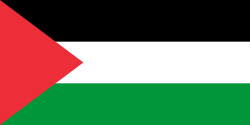
The symbols of Palestine include official and unofficial flags, icons or adopted cultural expressions that may be emblematic, representative or otherwise characteristic of Palestine and of its culture.
The scope of what is included in the symbols of Palestine includes the state flag and its ensign based on the Flag of the Arab Revolt. It also includes Palestinian vexillology and signs used by the Palestinian National Authority. [1] The fida'i is its national anthem. In 2015, the Palestinian Authority adopted the Palestine sunbird as the national bird of the State of Palestine. [2] [3] The Palestinian Authority passport has been described[ by whom? ] as a 'crucial symbol of nationhood.' [4] Postage stamps and postal history of the Palestinian National Authority also constitute a national symbol. The list of foundational symbols of Palestinian identity include:
- Al Aqsa (compound), particularly the Dome of the Rock [5] [6] [7]
- Handala [8] [9]
- the Palestinian key [10] [11]
- the Nakba
- the Palestinian keffiyeh [12] made famous by Yasser Arafat
- the watermelon [12]
Among the additional objects which are considered to be symbols of the Palestinian nation, is the native Palestinian poppy. Even though the national flower of Palestine is the Faqqua Iris, adopted in 2016, the poppy is red, with black center and green leaves, evoking the primary colors of the Pan-Arabic and Palestinian flag. [13] Jaffa oranges, [13] lemons, olive trees, [13] Battiri eggplants [14] and the cactus pear (sabr) [15] [13] are also widely used as symbols for the Palestinian nation. Other plants including za'atar (thyme) and handal (colocynth) [16] and traditional Palestinian crafts such as tatreez (Palestinian embroidery) are also considered national symbols. [12]












